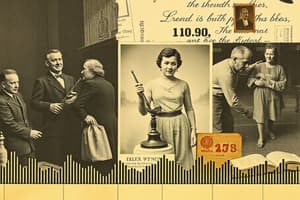Podcast
Questions and Answers
What is one potential consequence of inflation on the economy?
What is one potential consequence of inflation on the economy?
- Improved competitiveness in international trade
- Increased investment and savings
- Reduced investment, savings, and economic growth (correct)
- Stabilized real costs of goods and services
What tool can central banks use to control inflation?
What tool can central banks use to control inflation?
- Adjusting government spending
- Adjusting interest rates (correct)
- Regulating exports
- Increasing taxes
According to the Phillips Curve, what relationship is illustrated?
According to the Phillips Curve, what relationship is illustrated?
- No correlation between inflation and unemployment
- Inverse relationship between inflation and unemployment (correct)
- Direct relationship between inflation and employment
- Cyclical increase of inflation with employment increase
What is a characteristic of deflation?
What is a characteristic of deflation?
How can supply-side policies help in controlling inflation?
How can supply-side policies help in controlling inflation?
How is inflation typically measured?
How is inflation typically measured?
Which of the following is a characteristic of cost-push inflation?
Which of the following is a characteristic of cost-push inflation?
What is hyperinflation?
What is hyperinflation?
What does built-in inflation refer to?
What does built-in inflation refer to?
Which effect of inflation describes the erosion of money's value?
Which effect of inflation describes the erosion of money's value?
What type of inflation is characterized by a low and gradual increase in price levels?
What type of inflation is characterized by a low and gradual increase in price levels?
Which condition exemplifies demand-pull inflation?
Which condition exemplifies demand-pull inflation?
Who is typically benefited by inflation?
Who is typically benefited by inflation?
Flashcards
Inflation and Competitiveness
Inflation and Competitiveness
Inflation can make exports more expensive, potentially causing businesses to sell fewer products overseas.
Monetary Policy
Monetary Policy
Central banks can influence borrowing costs and money supply to impact inflation.
Fiscal Policy
Fiscal Policy
This policy involves adjusting taxes and government spending to manage inflation.
Deflation
Deflation
Signup and view all the flashcards
Phillips Curve
Phillips Curve
Signup and view all the flashcards
What is inflation?
What is inflation?
Signup and view all the flashcards
How is inflation measured?
How is inflation measured?
Signup and view all the flashcards
What is demand-pull inflation?
What is demand-pull inflation?
Signup and view all the flashcards
What is cost-push inflation?
What is cost-push inflation?
Signup and view all the flashcards
What is built-in inflation?
What is built-in inflation?
Signup and view all the flashcards
What is monetary inflation?
What is monetary inflation?
Signup and view all the flashcards
What is creeping inflation?
What is creeping inflation?
Signup and view all the flashcards
What is hyperinflation?
What is hyperinflation?
Signup and view all the flashcards
Study Notes
Definition and Measurement
- Inflation is a sustained increase in the general price level of goods and services in an economy over a period of time.
- It's typically measured by calculating the percentage change in a price index, such as the Consumer Price Index (CPI) or the Producer Price Index (PPI).
- These indexes track the average prices of a basket of goods and services consumed by households or produced by businesses, respectively.
- Inflation rates are usually expressed as annual percentage changes.
Causes of Inflation
- Demand-pull inflation: Occurs when aggregate demand in an economy outpaces aggregate supply. Increased consumer spending, investment, or government spending can drive up prices.
- Cost-push inflation: Arises when the cost of production increases, leading businesses to raise prices to maintain profit margins. Rising wages, raw material costs, or energy prices can be contributing factors.
- Built-in inflation: A self-reinforcing process where past inflation expectations influence current wage and price decisions. Workers demand higher wages to keep up with past price increases, leading businesses to raise prices further.
- Monetary inflation: An increase in the money supply not matched by a corresponding increase in output can lead to inflation.
Types of Inflation
- Creeping inflation: A low and gradual increase in the price level, typically a few percent per year.
- Galloping inflation: A rapid increase in prices, making it harder to plan for the future, typically a few tens of percent per year.
- Hyperinflation: An extremely rapid and out-of-control increase in the price level, often at rates exceeding 50% per month which severely damages the economy. This is extremely uncommon in modern economies.
Effects of Inflation
- Reduced purchasing power: Inflation erodes the real value of money, meaning the same amount of money buys fewer goods and services.
- Uncertainty and instability: Inflation can create uncertainty about future prices, making it harder for businesses to plan investment and for consumers to plan spending.
- Distortion of relative prices: Inflation can distort relative price signals in the market, leading to misallocation of resources.
- Income redistribution: Inflation disproportionately affects different groups in society, often benefiting debtors at the expense of creditors (those owed money).
- Economic inefficiency: Inflation can lead to reduced investment, savings, and economic growth.
- Reduced competitiveness: Inflation makes exports more expensive, potentially leading to a loss of market share in international trade.
Controlling Inflation
- Monetary policy: Central banks can use tools like adjusting interest rates to influence borrowing costs and control the money supply. Higher interest rates generally curb inflation.
- Fiscal policy: The government can use policies such as adjusting taxes and government spending to reduce aggregate demand and control inflation.
- Supply-side policies: Policies aimed at increasing the economy's productive capacity can help lower inflation by increasing the supply of goods and services.
The Phillips Curve
- The Phillips Curve illustrates an inverse relationship between inflation and unemployment.
- It suggests that lower unemployment often correlates with higher inflation, and vice versa.
- However, this relationship is not consistently observed in the long run, and the curve's shape and existence can change depending on circumstances and economic conditions.
Deflation
- Deflation is a sustained decrease in the general price level of goods and services.
- Deflation often has negative consequences for the economy, as it can lead to decreased consumption and investment, while increasing the real burden of debt.
Studying That Suits You
Use AI to generate personalized quizzes and flashcards to suit your learning preferences.




